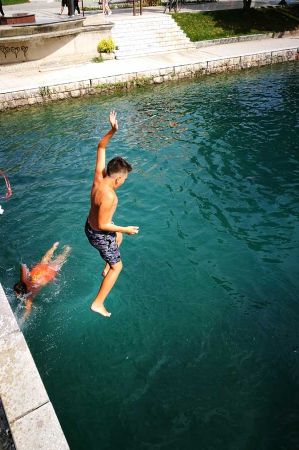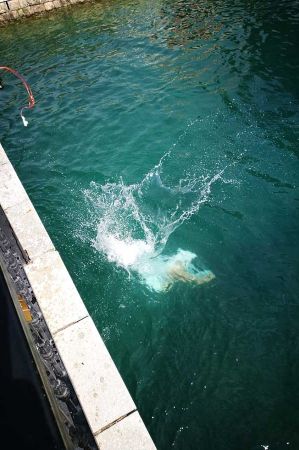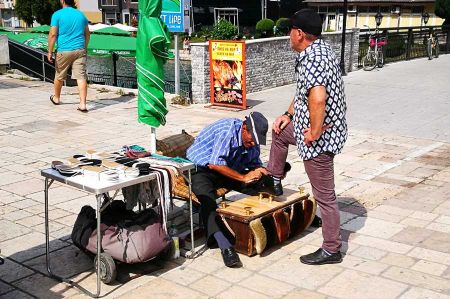Struga - shoeshine and bridge jumper at the Black Drin
- Written by Portal Editor
In Europe, you rarely encounter a public service provider who used to clean shoes to his customers: the shoeshine.
We were on the way along the new boardwalk along the Drin, as we first met some young people who sought to refresh by jumping from the bridge down into the Black Drin river. As in the whole of Western Europe, the temperatures here in Struga has risen to over 35 °, so it's no wonder that the cool water is being increasingly used. And by the way, in what place can you still bathe in the river due to the excellent water quality, which still flows through the middle of the city, accompanied by restaurant and street cafes on both sides? Many restaurant guest used the Black Drin for a refreshing bath in between.
Black Drin - outflow of water from the Ohrid lake
 The Black Drin, which drains Lake Ohrid, lies in the southwest Macedonian town of Struga at an altitude of 695 m, then flows 149 kilometers north through the mountainous landscape of western Macedonia and northeastern Albania. Already in Macedonia, the river passes two reservoirs, the Globočica Lake and the Debar Lake directly near Debar. Shortly after the great dam of Debar, the Black Drin reaches the border with Albania, which it forms for a few kilometers. After that, he completely relocates to Albanian territory. The further course of the river in Albania runs north through low-population, mountainous and impassable landscapes.
The Black Drin, which drains Lake Ohrid, lies in the southwest Macedonian town of Struga at an altitude of 695 m, then flows 149 kilometers north through the mountainous landscape of western Macedonia and northeastern Albania. Already in Macedonia, the river passes two reservoirs, the Globočica Lake and the Debar Lake directly near Debar. Shortly after the great dam of Debar, the Black Drin reaches the border with Albania, which it forms for a few kilometers. After that, he completely relocates to Albanian territory. The further course of the river in Albania runs north through low-population, mountainous and impassable landscapes.
Of course jumping from the bridge is not completely safe, but the fun factor seemed more important to the boys. But nobody seemed to object. In general, it was amazing to see how many of the guests in the cafes along the shore dipped into the cooling Ohrid lake water in between, swam a few puffs, and then return to the cafe.
Protective cleaner - the mobile nursing service is almost extinct
 The following meeting on the bridge over the Black Drin then reminded us of our encounters in Turkey, where the job of shoeshine in public is still widespread. Until the 1920s and 1930s, the mobile shoeshine was widespread in Central Europe too, today it is only occasionally to see, such as at fairs and other events, where it is used as a publicity stunt for customers. In many Asian countries such as in India, for example, this activity is still widespread today, unfortunately often as child labor.
The following meeting on the bridge over the Black Drin then reminded us of our encounters in Turkey, where the job of shoeshine in public is still widespread. Until the 1920s and 1930s, the mobile shoeshine was widespread in Central Europe too, today it is only occasionally to see, such as at fairs and other events, where it is used as a publicity stunt for customers. In many Asian countries such as in India, for example, this activity is still widespread today, unfortunately often as child labor.
There is also a social component in the presence of a shoeshine in the public, because comparable to the work of a hairdresser, the work of a shoeshine has a social function in local communication. A function that is almost always underestimated today. Certainly you will not have to describe the work of a shoeshine, its communicative presence and social impact, however, is little known.
The practice of a shoeshine under duress often had the sole purpose of shoe care and even served humiliation, reinforced by the stooped posture during work. Examples of this can be found during the Nazi dictatorship in concentration camps or in occupied countries.
Incidentally, the oldest photo on which people are depicted is the photograph of a street view from Paris in 1838 by Louis Daguerre, on which a shoeshine boy and his client were photographed.
Please read as well:
Station 10 - Camping Rino at Lake Ohrid - Feel like home
Hiking with alaturka - Lake Ohrid excursion from 18.09. to 25.09.2018
